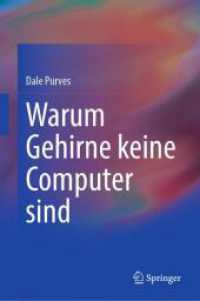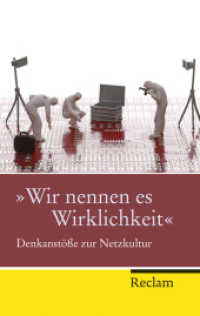- ホーム
- > 洋書
- > 英文書
- > Science / Mathematics
基本説明
Printed in full color to aid interpretation of materials simulations, this accessible and much-needed text includes all current methodologies based on electronic structure, interatomic potential, and hybrid methods.
Full Description
The development of materials for clean and efficient energy generation and storage is one of the most rapidly developing, multi-disciplinary areas of contemporary science, driven primarily by concerns over global warming, diminishing fossil-fuel reserves, the need for energy security, and increasing consumer demand for portable electronics. Computational methods are now an integral and indispensable part of the materials characterisation and development process.
Computational Approaches to Energy Materials presents a detailed survey of current computational techniques for the development and optimization of energy materials, outlining their strengths, limitations, and future applications. The review of techniques includes current methodologies based on electronic structure, interatomic potential and hybrid methods. The methodological components are integrated into a comprehensive survey of applications, addressing the major themes in energy research.
Topics covered include:
• Introduction to computational methods and approaches
• Modelling materials for energy generation applications: solar energy and nuclear energy
• Modelling materials for storage applications: batteries and hydrogen
• Modelling materials for energy conversion applications: fuel cells, heterogeneous catalysis and solid-state lighting
• Nanostructures for energy applications
This full colour text is an accessible introduction for newcomers to the field, and a valuable reference source for experienced researchers working on computational techniques and their application to energy materials.
Contents
About the Editors xi List of Contributors xiii
Preface xv
Acknowledgments xvii
1 Computational Techniques 1
C. Richard A. Catlow, Alexey A. Sokol, and Aron Walsh
1.1 Introduction 1
1.2 Atomistic Simulations 1
1.2.1 Basic Concepts 1
1.2.2 Parameterization 3
1.2.3 Parameter Sets 3
1.2.4 Implementation 4
1.3 Electronic Structure Techniques 6
1.3.1 Wavefunction Methods 8
1.3.1.1 Hartree-Fock Theory 9
1.3.1.2 Post-Hartree-Fock Approaches 10
1.3.1.3 Semi-empirical Wavefunction Methods 11
1.3.2 Density Functional Theory 12
1.3.2.1 Exchange-Correlation Functionals 12
1.3.2.2 Semi-empirical Density Functional Approaches 14
1.3.3 Excited States 15
1.4 Multiscale Approaches 15
1.4.1 Hybrid QM/MM Embedding Techniques 16
1.4.2 Beyond Atomistic Models 17
1.5 Boundary Conditions 19
1.6 Point-Defect Simulations 21
1.6.1 Mott-Littleton Approach 21
1.6.2 Periodic Supercell Approach 24
1.7 Summary 25
References 25
2 Energy Generation: Solar Energy 29
Silvana Botti and Julien Vidal
2.1 Thin-Film Photovoltaics 29
2.2 First-Principles Methods for Electronic Excitations 32
2.2.1 Hedin's Equations and the GW Approximation 34
2.2.2 Hybrid Functionals 38
2.2.3 Bethe-Salpeter Equation 40
2.2.4 Model Kernels for TDDFT 41
2.3 Examples of Applications 42
2.3.1 Cu-Based Thin-Film Absorbers 43
2.3.2 Delafossite Transparent Conductive Oxides 54
2.4 Conclusions 60
References 61
3 Energy Generation: Nuclear Energy 71
Dorothy Duffy
3.1 Introduction 71
3.2 Radiation Effects in Nuclear Materials 72
3.2.1 Fission 72
3.2.1.1 Structural Materials 73
3.2.1.2 Fuel 76
3.2.1.3 Cladding 79
3.2.2 Fusion 80
3.2.2.1 Structural Materials 81
3.2.2.2 Plasma-Facing Materials 82
3.2.3 Waste Disposal 83
3.3 Modeling Radiation Effects 85
3.3.1 BCA Modeling 86
3.3.2 Molecular Dynamics 87
3.3.2.1 Cascade Simulations 87
3.3.2.2 Sputtering Simulations 93
3.3.3 Monte Carlo Simulations 94
3.3.3.1 Kinetic Monte Carlo 95
3.3.3.2 Object Kinetic Monte Carlo 96
3.3.3.3 Transition Rates 97
3.3.3.4 Examples 98
3.3.4 Cluster Dynamics 99
3.3.4.1 Examples 99
3.3.4.2 Comparison with OKMC 100
3.3.5 Density Functional Theory 101
3.3.5.1 Interatomic Potentials 101
3.3.5.2 Transition Rates 102
3.4 Summary and Outlook 102
References 104
4 Energy Storage: Rechargeable Lithium Batteries 109
M. Saiful Islam and Craig A.J. Fisher
4.1 Introduction 109
4.2 Overview of Computational Approaches 110
4.3 Li-Ion Batteries 112
4.4 Cell Voltages and Structural Phase Stability 113
4.5 Li-Ion Diffusion and Defect Properties 116
4.6 Surfaces and Morphology 121
4.7 Current Trends and Future Directions 124
4.8 Concluding Remarks 125
References 125
5 Energy Storage: Hydrogen 131
Viet-Duc Le and Yong-Hyun Kim
5.1 Introduction 131
5.2 Computational Approach in Hydrogen Storage Research 133
5.3 Chemisorption Approach 133
5.4 Physisorption Approach 136
5.5 Spillover Approach 138
5.6 Kubas-Type Approach 138
5.7 Conclusion 145
References 146
6 Energy Conversion: Solid Oxide Fuel Cells 149
E.A. Kotomin, R. Merkle, Y.A. Mastrikov, M.M. Kuklja, and J. Maier
6.1 Introduction 149
6.2 Computational Details 152
6.3 Cathode Materials and Reactions 155
6.3.1 Surfaces: LaMnO3 and (La,Sr)MnO3 Perovskites 155
6.3.1.1 Surface Termination, Surface Point Defects 155
6.3.1.2 Oxygen Adsorption and Diffusion 158
6.3.1.3 Rate-Determining Step of the Surface Reaction 160
6.3.2 Bulk Properties of Multicomponent Perovskites 164
6.3.2.1 Oxygen Vacancy Formation in (Ba,Sr)(Co,Fe)O3-δ 164
6.3.2.2 Oxygen Vacancy Migration in (Ba,Sr)(Co,Fe)O3-δ 167
6.3.2.3 Disorder and Cation Rearrangement in (Ba,Sr)(Co,Fe)O3-δ 170
6.3.3 Defects in (La,Sr)(Co,Fe)O3-δ 173
6.4 Ion Transport in Electrolytes: Recent Studies 175
6.5 Reactions at SOFC Anodes 176
6.6 Conclusions 177
Acknowledgments 178
References 178
7 Energy Conversion: Heterogeneous Catalysis 187
Rutger A. van Santen, Evgeny A. Pidko, and Emiel J.M. Hensen
7.1 Introduction 187
7.1.1 Particle Size Dependence of Catalytic Reactivity 191
7.1.2 Activity and Selectivity as a Function of the Metal Type 192
7.1.3 Reactivity as a Function of State of the Surface 193
7.1.4 Mechanism of Acid Catalysis: Single Site versus Dual Site 193
7.2 Basic Concepts of Heterogeneous Catalysis 195
7.3 Surface Sensitivity in CH Activation 198
7.3.1 Homolytic Activation of CH Bonds 198
7.3.2 Heterolytic Activation of CH Bonds 203
7.3.2.1 Brønsted Acid Catalysis 204
7.3.2.2 Lewis Acid Catalysis 206
7.4 Surface Sensitivity for the C-C Bond Formation 209
7.4.1 Transition Metal Catalyzed FT Reaction 209
7.4.2 C-C Bond Formation Catalyzed by Zeolitic Brønsted Acids 213
7.5 Structure and Surface Composition Sensitivity: Oxygen Insertion versus CH Bond Cleavage 217
7.5.1 Silver-Catalyzed Ethylene Epoxidation 217
7.5.2 Benzene Oxidation by Iron-Modified Zeolite 221
7.6 Conclusion 223
References 224
8 Energy Conversion: Solid-State Lighting 231
E. Kioupakis, P. Rinke, A. Janotti, Q. Yan, and C.G. Van de Walle
8.1 Introduction to Solid-State Lighting 231
8.2 Structure and Electronic Properties of Nitride Materials 234
8.2.1 Density Functional Theory and Ground-State Properties 234
8.2.2 Electronic Excitations: GW and Exact Exchange 236
8.2.3 Electronic Excitations: Hybrid Functionals 240
8.2.4 Band-gap Bowing and Band Alignments 240
8.2.5 Strain and Deformation Potentials 241
8.3 Defects in Nitride Materials 243
8.3.1 Methodology 244
8.3.2 Example: C in GaN 246
8.4 Auger Recombination and Efficiency Droop Problem of Nitride LEDs 248
8.4.1 Efficiency Droop 248
8.4.2 Auger Recombination 249
8.4.3 Computational Methodology 251
8.4.4 Results 252
8.5 Summary 254
Acknowledgments 255
References 255
9 Toward the Nanoscale 261
Phuti E. Ngoepe, Rapela R. Maphanga, and Dean C. Sayle
9.1 Introduction 261
9.2 Review of Simulation Methods 263
9.2.1 Established Computational Methods 263
9.2.2 Evolutionary Methods 263
9.2.2.1 GM Methods 263
9.2.2.2 Amorphization and Recrystallization 264
9.3 Applications 266
9.3.1 Nanoclusters 266
9.3.1.1 ZnO 266
9.3.1.2 ZnS 268
9.3.1.3 MnO2 269
9.3.1.4 TiO2 271
9.3.2 Nanoarchitectures 272
9.3.2.1 MnO2 Nanoparticle (Nucleation and Crystallization) 272
9.3.2.2 MnO2 Bulk 275
9.3.2.3 MnO2 Nanoporous 278
9.3.2.4 TiO2 Nanoporous 284
9.3.2.5 ZnS and ZnO Nanoporous 286
9.4 Summary and Conclusion 289
Acknowledgments 290
References 290
Further Reading 295
Index 297








